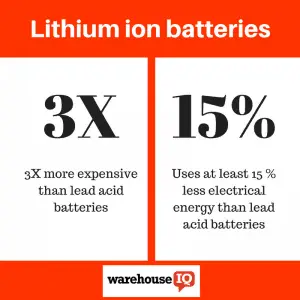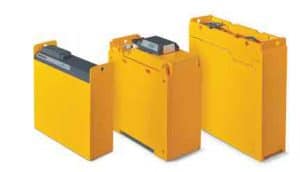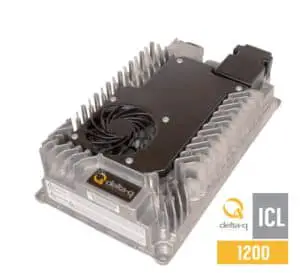How viable are lithium ion batteries on a forklift?
Lithium ion forklift battery Q&A
This question and answer session on lithium ion forklift battery technology was created in an interview with Chris Botting, Manager of Research at Delta-Q, a manufacturer of lift truck battery chargers.
How viable is lithium ion forklift battery technology? Is it still nascent or is it ready for prime time on forklifts?
Lithium ion batteries offer compelling advantages in forklifts, and with product offerings expanding and prices dropping, they are positioned for increased adoption.
What is the history of Lithium Ion batteries
The lithium ion battery was invented by John Bannister Goodenough, a German born physicist, who now lives in the U.S. He created the component called the cobalt-oxide cathode, which is the single most important part of the lithium-ion battery. Learn more here.
What is the cost to run a Lithium battery vs lead acid?
 The upfront cost of a lithium ion battery pack is currently at least three times that of an equivalent lead-acid battery pack.
The upfront cost of a lithium ion battery pack is currently at least three times that of an equivalent lead-acid battery pack.
However, the operating cost is lower for a lithium ion battery, as it typically uses at least 15 percent less electrical energy.
The case that holds a lithium ion forklift battery is also sealed, which eliminates maintenance requirements, such as watering. Additionally, the total cost of ownership can be lower, offering longer battery life and a warranty to reduce replacement costs, and potentially increased uptime and elimination of the need for battery change outs.
What are the different types of lithium ion forklift battery? How do they differ?
“Under the hood” of a lithium ion forklift battery pack there can be many technical differences. Major differences to original equipment manufacturers includes the size, shape, packaging, and chemistry of the cells, and the architecture of the battery management system. However, key differentiators for end users are increased productivity and a faster charge rate (in one hour or less), or slower conventional charging.
Batteries designed for conventional charge rates typically require four hours or more for a full charge. They may charge faster than equivalent lead-acid batteries, which require around eight hours for a full charge. Lithium ion batteries also may have longer run times, enabling a single-shift battery to stretch as far as two shifts per day. However, like the lead-acid batteries they replace, these lithium ion batteries cannot support continuous three-shift operation without changing the battery out.
In addition, batteries designed for fast charging require a much larger off-board charger, upgraded electrical cabling, and possibly active battery cooling. Charging at a one hour rate or faster generates significant heat in the battery and its cabling, requiring removal to avoid battery cycle life and warranty concerns. For lithium ion batteries, the benefit is that opportunity charging during break times and shift changes can allow continuous three-shift operation without battery change outs. This saves labour needs and costs and dedicated floor space, and also eliminates the capital cost of having multiple batteries for every lift truck (one for each shift).
Which Li batteries are endorsed by which lift truck manufacturers? Is there a trend toward one type or another?

Some lift truck OEMs offer their own lithium ion forklift battery solutions, with battery pack designs either developed in-house or outsourced. There are also an increasing number of third party lithium ion battery pack suppliers and systems integrators, some of whom boast OEM testimonials as well as regulatory agency approvals and certifications. However, no clear standards have emerged for interoperability and compatibility, beyond retrofitting into standard battery tray size dimensions.
What Li batteries and chargers are UL approved?
This is not a simple question to answer. In general, any industrial battery or charger used in a workplace should have certification from a nationally recognized testing laboratory such as UL.
The regulatory landscape for lithium ion batteries and chargers is still evolving, with multiple overlapping standards for different applications and regions, from agencies such as UL, UN, and IEC; global harmonization has not yet been achieved.
For example, Delta-Q’s chargers are certified to UL 1564 (industrial battery chargers), but new lithium-specific requirements have been introduced in recent months in UL 1564 supplement SB, so Delta-Q has been working closely with UL to achieve early certification of our lithium-capable chargers.
What are pros and cons of Li batteries? Can they be hazardous (i.e. exploding phones)?
Lithium ion batteries have compelling advantages over lead-acid, including: smaller size and weight, higher power, faster charging, longer cycle life and warranty, higher energy efficiency and are sealed for zero maintenance and acid corrosion.
The main drawback of a lithium ion forklift battery is higher upfront cost, although this continues to drop each year with economies of scale and continued manufacturing and materials innovation.
Lithium ion batteries are also perceived to be more complex, and to have safety risks. In reality, lithium ion batteries can be hazardous if not properly designed, manufactured, and integrated, but past failures in consumer electronics have been largely due to pushing for the highest possible energy density. With that being said, when replacing a lead-acid battery in an existing lift truck envelope, there isn’t the same extreme pressure to minimize the size and weight of a lithium ion pack (like with a consumer electronic device); the key metrics are more likely to be battery life, uptime, and operating efficiency. In addition, a big steel box design can protect the battery cells from physical abuse.
Most well-publicized lithium ion battery failures (e.g. laptops, cellphones, hoverboards, Boeing Dreamliner) have been with the oldest and most volatile lithium ion chemistry, lithium cobalt oxide (LCO). This battery type has high energy density, but is not suitable for large industrial batteries. The types of lithium ion of batteries being used in forklifts are modern, safer chemistries that are also being used in electric cars and buses. It remains essential to ensure that your lithium ion pack supplier has safety, quality and reliability built in to their system design.
What is the recycling method and how environmentally friendly is Li batteries vs. lead acid?
Lead-acid batteries have long boasted recycling rates of around 99 per cent. This is because there is established infrastructure and the lead metal has a scrap value that provides a financial incentive for recycling. Lithium ion batteries do not yet have scaled-up recycling infrastructures, and much of the ongoing effort to improve the cost of lithium ion batteries has focused on using less costly materials. This means there is less incentive to recycle lithium ion batteries because there will generally be a cost to do so.
What is the forecast for adoption of Li batteries over the next 5 to 10 years?
There are different opinions. Certainly, lead-acid batteries are not going away, and will continue to be the reliable, go-to workhorse solution for cost-sensitive applications. Adoption of lithium ion batteries is predicted to accelerate over the next five to ten years, as lithium ion battery prices will likely be cut in half or more. There are however many lithium ion offerings already available and with a compelling business case in high-use applications. Ultimately, lithium ion batteries will be increasingly adopted where operating cost and efficiency are valued.
What are the run times of Li batteries on forklift trucks vs. lead acid?
Lithium ion forklift battery technology has energy density up to three to four times higher than lead-acid batteries. This means that when replacing a lead-acid battery with lithium ion in the same form factor, it should be possible to get two to three times the run time, for example, stretching from one shift to two or three. But in practice, and due in part to prohibitive upfront costs, most lithium ion battery packs will replace lead-acid with similar or somewhat higher capacities. But for lift trucks, the selling points for lithium ion packs will tend to faster charging, longer life, or reduced operating costs, not much longer run times.
What is the Delta-Q charger solution and what are its advantages?
Delta-Q’s industrial chargers feature a high reliability, automotive-style design suitable for onboard mounting. A sealed, die-cast design can handle pressure washing, dust and corrosion, extreme shock and vibration, and thermal shock (cold storage), all in a compact, power-dense package. For example Delta-Q’s chargers have been successfully integrated into many class 3 “walkie” battery cassettes, where incumbent chargers suffered from poor reliability.
All of Delta-Q’s chargers feature universal AC input for global use, and have regulatory approvals for use in all major global markets, including California Energy Commission’s battery charger energy efficiency standards.
With fully customizable and field replaceable cable design, our chargers provide OEMs with flexibility in design and deployment. Additionally, our battery experts develop unique profiles that meet performance, health and charging time requirements, creating an improved user experience, better runtime and flexibility for different battery chemistries.
What features do Delta-Q solutions provide that are innovative?

Delta-Q has several different charger families with different feature sets and user interfaces suitable for onboard and offboard applications, and different battery types. We’ve recently launched a new “ICL” family of chargers that are purpose built exclusively for lithium ion battery applications, supporting multiple battery management system (BMS) communication and control options. The ICL 1200 and ICL 900 battery chargers are suitable for use on any electric machine including lift trucks, scooters, floor care machines and sports and utility vehicles.
Machine integration options include Controller Area Network (CAN-bus) communications and carries a comprehensive set of global regulatory approvals, including touch-safe requirements for the European electric vehicle market. Integration also includes USB host port for easy diagnostics, data transfer, software updates, and local and remote status indication – offering flexible methods to communicate with the battery management system (BMS).
Where can warehouse managers learn more about Delta-Q products?
For more information on the benefits of Delta-Q’s chargers for lift trucks, see: www.delta-q.com/application/lift-truck-battery-chargers
For more resources on lithium ion batteries from Delta-Q, see:
- Infographic: https://delta-q.com/infographic-lithium-ion-battery-charging/
- Webinar: http://charger.delta-q.com/lithium-webinar/
More battery articles on this site:
- Do hydrogen fuel cells for forklifts make sense?
- Forklift battery charger selection guide
- How to charge forklift batteries
- My forklift battery smells like rotten eggs
- The truth about lithium ion batteries
***
Do you have an area of expertise in the warehouse, supply chain and logistics business? Contact editor Andy Walker at WarehouseIQ to pitch a Q&A. [email protected]


